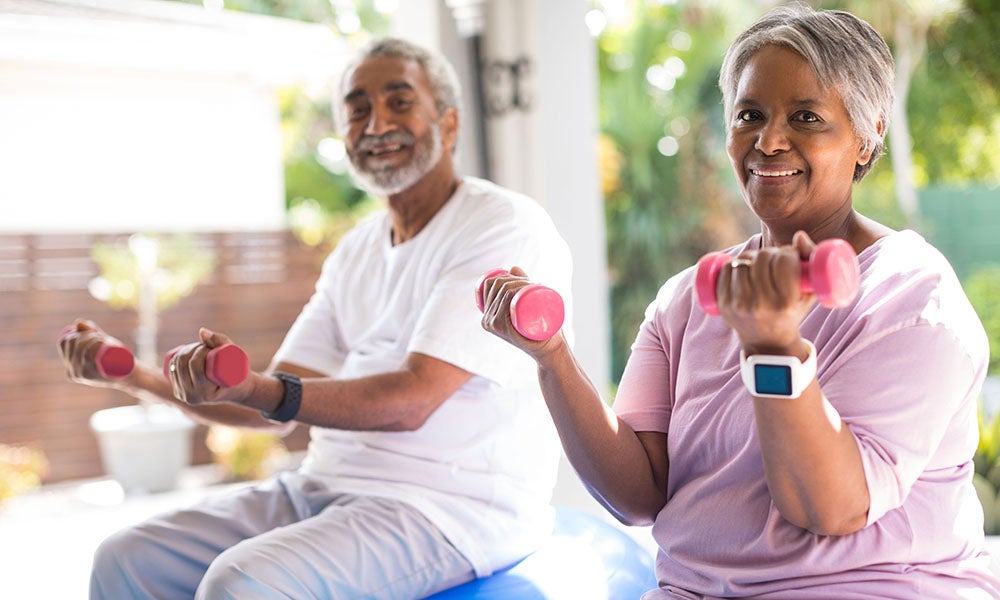A Guide to Improving Muscle Tone & Building Muscle After Age 60

Strength at every age
For older adults, there are many benefits to beginning a strength training routine, and improving muscle tone is an important aspect of physical fitness while aging. It’s not too late to start; in fact, studies show the body remains responsive to muscle-building exercises, regardless of age and when you begin.
“Building muscle after age 60 can lead to improved mobility, stability and strength. It can help prevent or delay the onset of several age-related conditions (such as arthritis and osteoporosis), leading to an extended quality of life and ability to remain independent,” said Nathan L. McKinney, D.O., orthopedic sports medicine specialist with Norton Orthopedic Institute and Norton Sports Health. “Strength training exercises also can help boost mood and improve overall mental health and well-being.”
Sarcopenia, which is the gradual loss of muscle strength and mass, is an age-related concern that can cause declines in physical health, including strength, vitality, balance and overall functioning in daily activities. It is commonly associated with a higher risk of falls among older adults. Although sarcopenia is a natural part of the aging process, its impacts can be reduced through exercises that improve muscle tone, such as a regular strength training routine. The Centers for Disease Control and Prevention recommends older adults supplement regular aerobic exercise with at least two days of muscle strengthening exercises per week.
In this article, we will explore the importance of building muscle tone among older adults, address common concerns and share practical tips and exercise ideas, specifically targeted to older adults, to help guide you along your fitness journey.
Understanding muscle tone
Muscle tone is the amount of tension muscles can hold, which helps us perform controlled movements and keeps our bodies sitting and standing upright. It is directly tied with the amount of movement someone is capable of performing, including mobility, stability and balance. For older adults, improved muscle tone can lead to improved posture, joint health and a reduced risk of falling. As we age, our bodies naturally experience a gradual decline in muscle mass. Therefore, it is important for older adults to perform activities that can preserve, enhance and even build muscle tone.
Practical strength exercises for older adults
Strength training isn’t just about lifting weights; it can include activities like using your own body weight, resistance bands and chairs. You don’t need a gym membership to start. Many of these exercises can be completed at home and built into your daily routine.
Building muscle after age 60 involves incorporating safe strength exercises that target different muscle groups, with modifications to accommodate various skill levels and physical abilities. Practical ideas for strength training exercises include:
Norton Sports Health
We want to help you start your fitness journey, regardless of age or skill level! Our specialists are trained to support older adults with an exercise routine that will meet their unique needs.
Sign up today for Senior LIFEready classes at the Norton Sports Health Performance & Wellness Center.
(502) 409-8888
1) Chair squats: Begin by sitting in a chair and standing up while extending your arms forward. You can use the chair for support and adjust the depth of your squat based on your personal comfort and ability.
2) Resistance band pulls: Put a resistance band around a fixed point, such as around your foot or in each hand, and pull the band to engage your arm and back muscles. Adjust the resistance by choosing bands with a tension that works well for you.
3) Leg raises: While seated or lying down, lift one leg at a time to engage your leg and core muscles. Seated leg raises provide more stability.
4) Wall push-ups: Place your hands on the wall, standing an arm’s length away, and perform push-ups against the wall. Adjust your distance from the wall to change control or intensity.
5) Seated dumbbell workout: With a straight back, sit down while holding a dumbbell or resistance band. Pull the dumbbell toward your chest or push above your head (depending on the exercise you choose). Select weights light enough that you can perform the exercise with controlled movements.
6) Toe taps: While seated, alternate tapping your toes on the ground. Engage your leg muscles and increase the pace for more intensity.
7) Balancing exercises: Stand on one leg or perform heel-to-toe walking to improve your balance and core strength. Use a chair, counter or wall for support if needed.
Lifestyle tips for maintaining muscle tone
Building muscle after age 60 is about more than exercise. It’s a series of lifestyle habits that promote muscle health, including proper nutrition, hydration and adequate rest.
Nutrition: Be sure your diet includes plenty of protein, which promotes muscle growth and repair after workouts. Lean protein sources include poultry, fish, beans and nuts. A balanced, nutrient-dense diet that includes protein, healthy carbs, vegetables and fruit is necessary. Vitamin deficiencies can impact muscle function. Talk to your provider about your nutrition habits for additional guidance.
Hydration: Drinking water can reduce muscle cramps and is important for overall health. You should aim for at least six to eight glasses of water per day. Be sure to hydrate before, during and after your workouts.
Rest: Aim for seven to nine hours of sleep per night to support your overall health and muscle growth and recovery. Muscles need time to recover and grow, so while it’s good to challenge yourself, don’t overdo it.
Daily walks: Walking is a low-impact exercise that is easily accessible. Walk around your neighborhood, in a local park or on a treadmill indoors. You can do it as a solo activity, include a friend for social connection or join a walking group.
Regular physical activity lays the foundation for building muscle tone after age 60. Incorporating these changes can lead to a healthier, more vibrant lifestyle as you age.
Addressing concerns: Muscle tone and aging bodies
There are several common misconceptions about older adults’ ability to build muscle after age 60.
Common concerns include:
1) Fear of pain or injury. Some people worry that they are too old to participate in strength training, and that they are guaranteed to injure themselves, especially if they have not been active for some time. While it is good to be mindful of possible injuries and one’s own abilities, there are many safe activities that align with a person’s health conditions and skill levels. Low-impact exercises, when under proper guidance and done with gradual progression, significantly can reduce the risk for injuries.
2) Too late to start. Many older adults believe that they’ve “missed the boat” when it comes to building muscle after age 60. However, you still can build muscle through resistance training, no matter your age, skill or activity level. Research demonstrates that older adults can improve muscle tone, strength and function regardless of when they start. Strength exercises can improve bone density, balance, metabolism and more.
Motivation and accountability
For older adults, building muscle after age 60 requires dedication and motivation. Strength exercises require consistency, repetition and effort over a period of time to see results. It’s important to explore strategies for remaining motivated, including setting realistic goals and seeking social support.
1) Set realistic goals. Starting a strength exercise routine shouldn’t involve a drastic overhaul of your current life. Start small and make regular promises to show up for yourself consistently. Setting realistic goals, such as completing a strength workout twice per week, can make it easier to track and celebrate your progress.
2) Understand your “why.” Tap into your internal motivation by reflecting on your reasons for wanting to build muscle. Is it to avoid falling? Retain your independence? Regularly remind yourself why you are doing these workouts and the positive impact it can have on your life.
3) Get social support. Surround yourself with positive people who will cheer on your progress. Maybe you have a workout partner or walking buddy. Perhaps you would enjoy the accountability and community that comes with group activities, such as walking clubs and workout classes.
4) Seek professional guidance. Consider seeking support from health care providers and fitness professionals who specialize in fitness for older adults, such as the team at Norton Sports Health, who can tailor workouts to your individual needs, preferences and current health conditions. This also can help with guidance on proper form, which can reduce the risk of injury.
When it comes to building muscle after age 60, older adults need to remember to be consistent. Schedule regular workouts at similar times every week. Mix up your routine to avoid getting bored or burned out. Start low and go slow; start with low impact exercises and low weights and progress gradually to build strength and avoid injury. Use technology, such as fitness apps or watches, to track and celebrate your progress.
Building a stronger future
Remember, it’s never too late to prioritize your physical health, and the journey to improved muscle tone while aging can be an empowering one! Strength training plays a key part in healthy aging, and for older adults, building muscle after age 60 can be an attainable and rewarding experience. However, it is necessary to consult with health care providers before beginning any new exercise routine. The team at Norton Sports Health is ready with its expertise to support older adults — of any age or skill level — with personalized fitness routines and guidance tailored to your unique needs.
link








